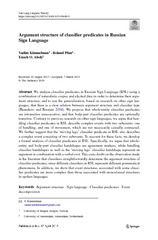Argument structure of classifier predicates in Russian Sign Language
Peer reviewed, Journal article
Published version

Åpne
Permanent lenke
https://hdl.handle.net/1956/19700Utgivelsesdato
2019-04-03Metadata
Vis full innførselSamlinger
Originalversjon
https://doi.org/10.1007/s11049-019-09448-9Sammendrag
We analyze classifier predicates in Russian Sign Language (RSL) using a combination of naturalistic corpus and elicited data in order to determine their argument structure, and to test the generalization, based on research on other sign languages, that there is a clear relation between argument structure and classifier type (Benedicto and Brentari 2004). We propose that whole-entity classifier predicates are intransitive unaccusative, and that body-part classifier predicates are optionally transitive. Contrary to previous research on other sign languages, we argue that handling classifier predicates in RSL describe complex events with two subevents: one of handling, and one of movement, which are not necessarily causally connected. We further suggest that the ‘moving legs’ classifier predicate in RSL also describes a complex event consisting of two subevents. To account for these facts, we develop a formal analysis of classifier predicates in RSL. Specifically, we argue that whole-entity and body-part classifier handshapes are agreement markers, while handling classifier handshapes as well as the ‘moving legs’ classifier handshape represent an argument in combination with a verbal root. This casts doubt on the observation made in the literature that classifiers straightforwardly determine the argument structure of classifier predicates, since different classifiers in RSL represent different grammatical phenomena. In addition, we show that event structures associated with some classifier predicates are more complex than those associated with monoclausal structures in spoken languages.
